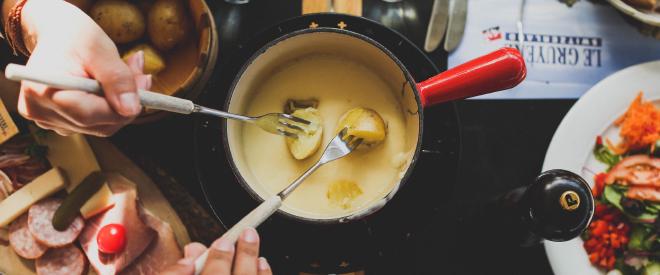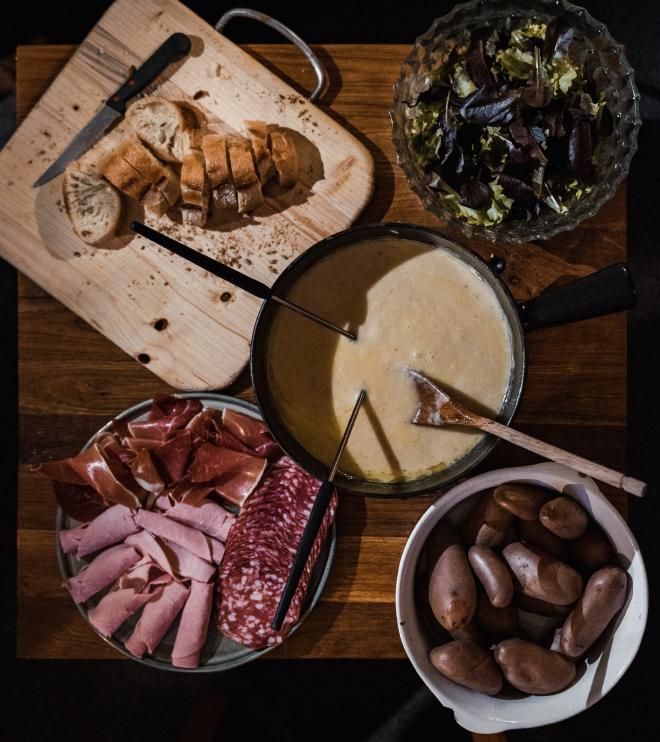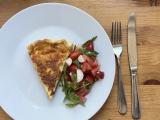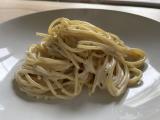Swiss Cheese Fondue
Table of Contents
Jump to Recipe
Jump to Carbon Footprint
Cheese, bread, wine, a little garlic and spices - Swiss cheese fondue is ready. It may be the simplest of meals, but it is also the most delicious, especially on a cold winter’s day.

I live in Switzerland, and if there is such a thing as a national dish, it must be fondue. Originally a peasant dish from the French-speaking part of Switzerland, it became increasingly popular throughout the country in the 20th century - partly thanks to a fork and pan hire service, because unlike today, not every Swiss household had the necessary equipment (source).
The main ingredients are cheese, bread, wine and a little starch to bind them together. As a rule of thumb, the amount of bread is about the same as the amount of cheese. To ensure that the cheese and wine combine well to form a homogeneous mass, it is important to heat everything slowly, stirring constantly with a spoon in the shape of an eight.
Despite the simplicity of the basic ingredients, Swiss fondues are now available in a wide range of variations. Almost every fondue restaurant swears by a little trick (sparkling wine instead of white! garlic and paprika!). And apart from the classic version, you can find everything from beer fondue to ginger and lemon fondue…
Fondue Variations #
The classic fondue is called moitié-moitié, which means “half and half”, but there are a whole range of cheese blends:
- Fondue Moitié-Moitié is the classic, half Gruyère and half Vacherin fribourgeois.
- The Valais fondue is a slight variation, with half Vacherin, a quarter Gruyère and a quarter Raclette.
- Central Swiss fondue contains one third Gruyère, one third Emmental and one third Sbrinz (a local cheese similar to on Parmesan).
- Appenzell fondue is made entirely from the Appenzell cheese of the same name.
- Fondue Savoyarde is a French version with one third Emmental, one third Beaufort and one third Comté.
Personally, I prefer the classic moitié-moitié version - especially when, towards the end, a crispy layer of cheese has formed on the bottom, which is called “réligieuse” in French-speaking Switzerland and can be scraped off the bottom of the pot with a fondue fork or scraper.
Side Dishes for Fondue #
The classic accompaniments to fondue are white bread cut into small pieces or boiled new potatoes. Baguette is generally a good accompaniment, but in Switzerland there is a special fondue bread.
A mixture of freshly ground pepper and nutmeg looks good on the plate, in which the fondue fork can be dipped with the hot piece of bread and cheese. Of course, you can get a bit more creative with the mixture and add some paprika or other spices.
A platter of cured meats, gherkins and pickled onions is also often served. There are now vegetarian options for the dried meat.
Sometimes, towards the end, when a crispy layer of cheese begins to form on the bottom of the caquelon, an egg is added to the pot while it is still hot.

Recipe #
Swiss Cheese Fondue
20 minutes
2 portions
Ingredients #
- 2 garlic cloves
- 1 tablespoon oil
- 200 ml white wine
- 1/2 teaspoon lemon juice
- 400 g grated hard cheese (see above for varieties)
- 2 teaspoon cornflour
- 2 cl cherry brandy (optional)
- about 400 g bread
Directions #
- Peel and finely chop the garlic.
- Heat the caquelon on the stove and sauté the garlic in a little oil.
- Mix the wine, lemon juice, cheese, cornflour and cherry brandy, then add to the casserole and heat slowly, stirring constantly.
- Cut the bread into small cubes and serve with the fondue. To keep the fondue warm and liquid, place the caquelon on a rack and set fire to the bowl of fuel paste underneath.
Fondue Problems #
It’s supposed to be cheese with wine, but sometimes it just doesn’t want to become a homogeneous mass. These tips will help you solve the most common problems:
- Help, my fondue is too runny! No problem, raise the temperature a little and keep stirring to reduce the liquid. You can also mix some cornflour in cold water, add to the fondue and stir well.
- Help, my fondue is too thick! No problem, just add some white wine to the fondue, raise the temperature a little and stir until everything is combined.
- Help, my fondue is separating! No problem, just put the fondue on the hob, dissolve some cornflour in white wine, add to the fondue, stir and bring to the boil. The starch will help the fondue to stick together.
After the Fondue #
To be honest, cleaning the pot is almost more complicated than making the fondue, not least because of the stubborn cheese residue that sticks to the pot. To make things easier, you can let the pot cool a little and then soak it in water and a dash of washing-up liquid. (If you have a ceramic caquelon, do not pour cold water directly into a very hot pot - the temperature difference could cause it to crack).
Unfortunately, the only way to get rid of the smell of cheese in your home is to air the room thoroughly…
Carbon Footprint #
The estimated carbon footprint of cheese fondue depends heavily on how you estimate the carbon footprint of cheese. I found different values in a total of six different sources, which lead to significant differences and result in an estimated carbon footprint of between 3056 g and 10216 g for two portions of cheese fondue. The median of the six recipes is 4294 g.
This ranks it number 56 out of 57 recipes published on the blog so far in terms of estimated carbon footprint.
In other words, it is one of the five recipes with the worst carbon footprint. 😱This puts it roughly in the same range as the reference recipes with meat such as Lasagne (3988 g) or veal escalope with potato salad (4702 g). In other words, fondue is not very climate-friendly…
The following table shows the differences between the different sources. The range of values is due to the fact that the studies make different assumptions and delimitations: What feed are the cows given? How is the CO2 balance split between milk and meat? How much milk does a cow produce? Is forest cleared for pasture? These factors are also interrelated - for example, the milk produced and the feed used. This is a simple example, but it illustrates the complexity of the carbon footprint issue.
| Source for cheese | carbon footprint per kg of cheese | carbon footprint (in g) for 2 portions of fondue |
|---|---|---|
| IFEU | 6.0 | 3056 |
| Agribalyse 3.0 | 6.3 | 3164 |
| MyEmissions.green | 8.8 | 4172 |
| Klimateller / Eaternity | 9,4 | 4416 |
| Plate up for the Planet | 12.3 | 5564 |
| Poore and Nemecek 2018 | 23.9 | 10216 |
For the following graph and table I use the cheese carbon footprint from MyEmissions.green.
As far as the ingredients are concerned, it is of course the cheese that dominates: in total, cheese accounts for only 38% of the weight of the ingredients in a cheese fondue, but for about 84% of the greenhouse gas emissions. All the other ingredients pale into insignificance: bread also accounts for 38% of the weight of the ingredients, but only 7% of the emissions of the cheese fondue.
| ingredient | carbon footprint per kg | carbon footprint (in g) for 2 servings | % of ingredients | % of CO2 emissions |
|---|---|---|---|---|
| Garlic | 0.5 | 3 | 1% | 0% |
| Oil | 3.2 | 32 | 1% | 1% |
| White wine | 1.0 | 200 | 19% | 5% |
| Lemon juice | 0.6 | 2 | 0% | 0% |
| Cheese | 8.8 | 3516 | 38% | 84% |
| Corn starch | 1.2 | 12 | 1% | 0% |
| Cherry brands | 2.3 | 46 | 2% | 1% |
| Bread | 0.7 | 280 | 38% | 7% |
| Cooking | 80 | 2% |


